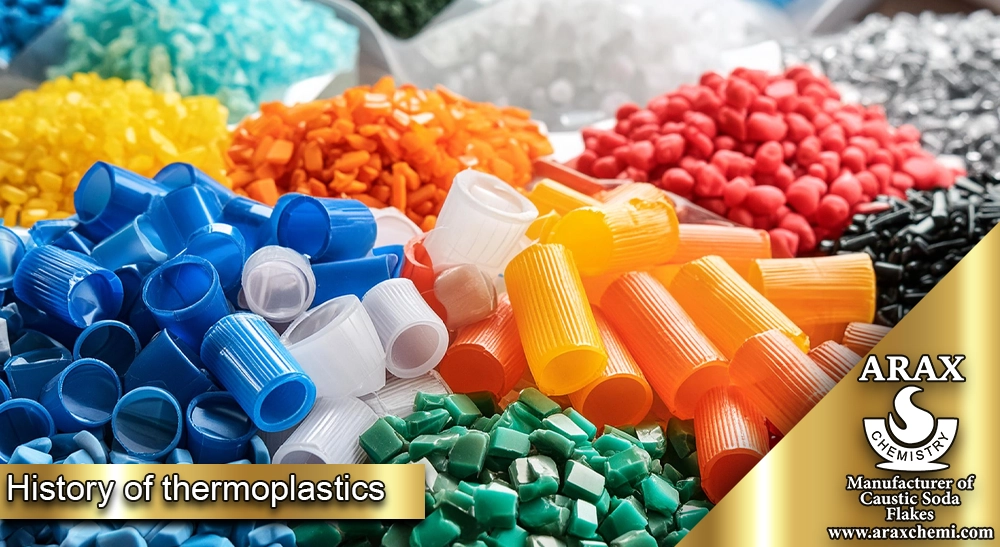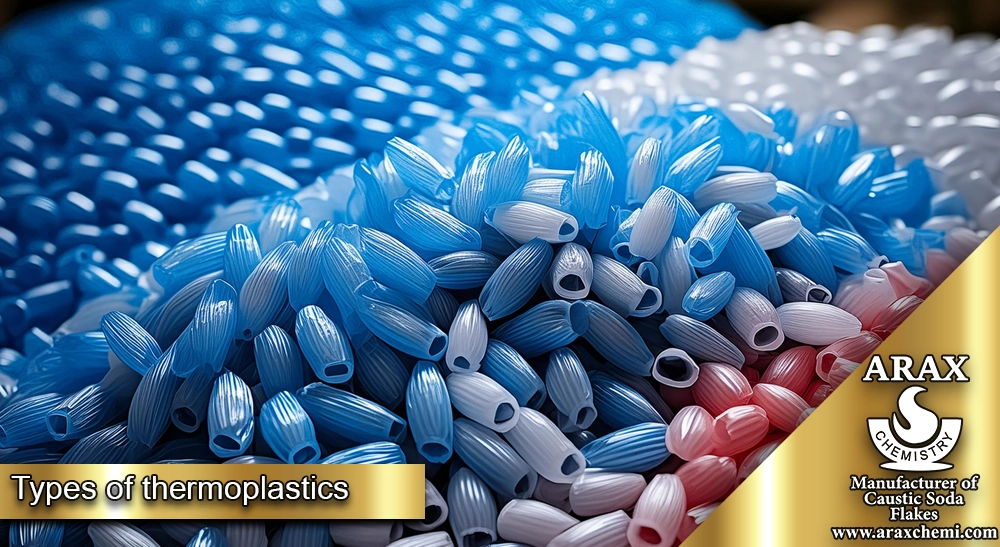What is Thermoplastic?
Thermoplastics are a type of polymer that have become widely used in many industries due to their specific properties. These materials can change shape under the influence of heat and retain their new shape after cooling. This feature has made thermoplastics very popular in manufacturing processes. Although these materials are used in a wide range of everyday products, a more precise understanding of their nature and applications can provide a better perspective on their importance. In this article, we will explore thermoplastics and their significance in various industries.
History of Thermoplastics
The history of Thermoplastic dates back to the 19th century, and with scientific and technological advancements, their development and application have significantly increased. Below is a brief overview of the history of thermoplastics:
Late 19th Century
In 1862, nitrocellulose, the first known Thermoplastic, was introduced by Alexander Parkes at the International Exhibition in London. This material, also known as “Parkesine,” is recognized as the first synthetic plastic in the world.
John Wesley Hyatt improved nitrocellulose and produced celluloid in 1870. This material is considered the first commercially successful Thermoplastic and was used to make billiard balls, dentures, and photographic films.
Early 20th Century
Leo Hendrik Baekeland produced Bakelite, the first thermosetting plastic, in 1907, marking a new chapter in the plastics industry. Although Bakelite was not a Thermoplastic, its development paved the way for the research and production of new types of polymers.

Wallace Carothers at DuPont developed nylon in 1926. Nylon was the first synthetic polymer widely used in textiles and other products, representing a significant advancement in polymer science.
Mid-20th Century
Polyethylene, one of the most important and widely used Thermoplastic, was discovered by Eric Fawcett and Reginald Gibson in 1933 in England. Initially used for military applications during World War II, it later found applications in packaging and pipes.
Giulio Natta and Karl Ziegler successfully polymerized polypropylene in 1954. Due to its excellent mechanical properties and high chemical resistance, polypropylene is widely used in various industries.
Late 20th Century and Early 21st Century
The development of engineering Thermoplastic such as polycarbonate and polyamide (nylon) began in the 1970s. These materials were used in high-performance applications such as automotive parts, electrical, and electronic equipment.
From the 1990s onwards, with advancements in nanotechnology and further research in polymers, Thermoplastic with special properties and high performance were produced. These materials are used in advanced industries such as aerospace, medicine, and electronics.
The history of thermoplastics illustrates significant transformations in the science and industry of polymers. From the discovery of nitrocellulose in the 19th century to the development of advanced polymers in the 21st century, thermoplastics have played a key role in industrial advancements and improving the quality of life. With continued research and innovations, the applications and importance of these materials are expected to increase in the future.
Importance and Broad Applications of Thermoplastics in Various Industries
Thermoplastics are highly significant in various industries due to their unique characteristics and have found extensive applications. Below are some of the main reasons for the importance and applications of thermoplastics in different industries:

Importance of Thermoplastics
Recyclability
One of the most important features of thermoplastics is their high recyclability. These materials can be remelted and reshaped into new forms, which is very important from an environmental perspective.
Lightweight and Strength
Due to their lightweight and high mechanical strength, thermoplastics are used in many industrial and consumer applications.
Flexibility in Manufacturing
These materials can be easily reshaped under heat, making them ideal for various manufacturing processes.
Chemical Resistance
Many thermoplastics are resistant to various chemicals, making them suitable for specific applications.
Broad Applications in Various Industries
Automotive Industry
In this industry, thermoplastics are used to manufacture interior and exterior car parts, such as dashboards, bumpers, and decorative components. Their lightweight and high strength help improve efficiency and reduce fuel consumption in vehicles.
Packaging Industry
Due to their transparency, lightweight, and high impact and moisture resistance, Thermoplastic are used to make various packaging for food, pharmaceuticals, and industrial products.
Electronics and Electrical Equipment
Thermoplastics are used to manufacture various components such as housings for mobile phones, computers, and other electrical devices. These materials are good electrical insulators and protect devices from impact and heat.
Medical Industry
Thermoplastics are used in producing medical equipment such as syringes, medical tubes, and sterile packaging. Due to their sterilization capability and safety for the human body, they are highly regarded.
Construction Industry
In this industry, Thermoplastic are used to make pipes, fittings, window and door profiles, and thermal and sound insulations. High corrosion resistance and lightweight are important features of these materials in construction applications.

In conclusion, Thermoplastic have revolutionized many industries with their unique properties and extensive applications. Their development has been a testament to the advancements in polymer science and technology, continuously pushing the boundaries of what these materials can achieve.
Physical and Chemical Properties of Thermoplastics
Thermoplastics exhibit a variety of mechanical, thermal, and chemical properties due to their diverse structures and chemical compositions, making them suitable for a wide range of applications. Here, we explore these properties in detail:
Physical Properties
Tensile Strength
Many Thermoplastic, especially polyethylene, polypropylene, and nylon, have high tensile strength. This makes them suitable for applications requiring resistance to stretching.
Flexibility
Thermoplastics are generally flexible and can deform under pressure and stress without breaking. This property is particularly important in packaging and automotive parts.
Impact Resistance
Many Thermoplastic, such as polycarbonate, exhibit high impact resistance, making them ideal for applications requiring resistance to shocks and impacts.
Surface Hardness
Some thermoplastics, like polyamide (nylon), have high surface hardness, making them suitable for engineering and mechanical parts.
Thermal Properties
Melting Temperature
Thermoplastics have varying melting temperatures depending on the type of polymer and its structure, usually ranging from 100 to 300 degrees Celsius. For example, low-density polyethylene (LDPE) has a melting point of around 115 degrees Celsius, while polycarbonate has a higher melting point.
Chemical Properties
The chemical properties of thermoplastics play a crucial role in determining their applications across different industries. These properties include:
Chemical Resistance
Many thermoplastics exhibit good resistance to acids, bases, organic solvents, and various chemicals. For instance, polyethylene and polypropylene have excellent chemical resistance, making them suitable for applications exposed to such substances.
Low Water Absorption
Many thermoplastics, like polyethylene and polypropylene, have very low water absorption, making them ideal for applications exposed to moisture and water, such as plumbing and food packaging.
Resistance to Oxidation
Some thermoplastics, such as polypropylene, are highly resistant to oxidation. This property ensures their durability and stability when exposed to air and oxygen.
UV Resistance
Some Thermoplastic, like polycarbonate and polyethylene terephthalate (PET), have good resistance to degradation from UV radiation. This makes them suitable for outdoor applications and exposure to sunlight.
Insolubility in Water
Most Thermoplastic are insoluble in water, aiding their use in moist and aquatic environments.
Resistance to Hydrolysis
Certain Thermoplastic, like polyamides (nylon), have good resistance to hydrolysis, making them suitable for applications exposed to water and steam.
Non-reactivity with Food
Thermoplastic like polyethylene and polypropylene are non-reactive with food and safe for human health, making them ideal for food packaging.
Types of Thermoplastics and Their Applications
- Polyethylene (PE): flexible and resistant to breaking, used in packaging and piping
- Polypropylene (PP): resistant to heat and chemicals, used in packaging and car parts.
- Polystyrene (PS): transparent and light, used in disposable containers and packaging
- Polyethylene terephthalate (PET): transparent and resistant to moisture, used in beverage bottles and plastic films.
- Polyvinyl chloride (PVC): resistant to heat and flame, use in pipes and flooring.
- Polycarbonate (PC): transparent and resistant to impact, use in safety glass and medical equipment
- Nylon (PA): resistant to abrasion and impact, use in engineering parts and fibers.
- Acrylonitrile Butadiene Styrene (ABS): impact resistant, used in home appliances and automobil parts.
- Low density polyethylene (LDPE): flexible and resistant to breaking, use in bags and bottles
- High density polyethylene (HDPE): hard and resistant, use in pipes and containers.
- Polyphenylene oxide (PPO): resistant to heat and chemicals, use in electrical and electronic components
- Polysulfone (PPSU): heat and chemical stable, used in medical parts and water filters.
- Polymethyl methacrylate (PMMA): transparent and impact resistant, used in windows and displays
- Polybutylene terephthalate (PBT): resistant to heat and wear, use in electrical parts and car parts.
- Polyphenylene sulfide (PPS): resistant to heat and chemicals, use in engineering and electrical parts.

Recycling Capability of Thermoplastics
The recycling capability of thermoplastics is undoubtedly an important and noteworthy aspect. Thermoplastics can often be recycled, meaning they can be reused or recycled as raw materials for the production of new products. This feature is significant due to its numerous environmental, economic, and social benefits.
Environmental Conservation: Recycling Thermoplastic reduces the use of natural resources like oil and gas and helps reduce air and soil pollution and the volume of solid waste.
Cost Savings: Reusing Thermoplastic means saving on production costs. Recycling materials can reduce production expenses and increase the profitability of companies.
Prolonging Product Lifespan: Recycling Thermoplastic can extend the lifespan of products, as recycled materials can enhance the quality and flexibility of products.
Job Creation and Local Economy: The Thermoplastic recycling industry can create new employment opportunities and help develop the local economy.

Conclusion
Thermoplastic are a category of polymers that become soft at high temperatures and hard at low temperatures, a unique feature that distinguishes them from other polymers. Unlike thermosets, which cannot be reshaped once hardened, thermoplastics can undergo multiple heating and cooling cycles and be reshaped each time. This property makes Thermoplastic one of the most versatile and widely used materials in various industries. From packaging and automotive to electronics and medical equipment, thermoplastics play a significant role due to advantages like chemical resistance, lightness, and high recyclability. This article examines the properties, types, and diverse applications of thermoplastics, analyzing the reasons for their growing popularity in today’s world.

